Sony HDR-CX6EK MemoryStick Camcorder Review
Sony HDR-CX6EK MemoryStick Camcorder
Has Sony's HDR-CX6EK camcorder got more than just pocket-friendly appeal?
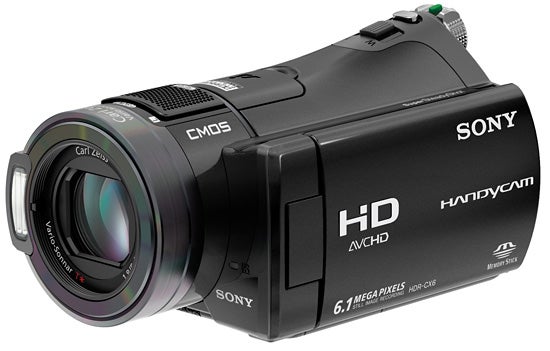
Verdict
Key Specifications
- Review Price: £659.99
The writing may be on the wall for tape, but its successor is far from certain just yet. Hard disk camcorders still have the upper hand in terms of storage capacity, but you can’t beat Flash Memory for enabling the smallest, most desirable form factors. Sony, of course, has gone its own way in this respect and incorporated its proprietary MemoryStick format into camcorders, rather than Secure Digital. Latest in this line is the HDR-CX6EK. Weighing in at 450g including a battery, it’s a little larger than Panasonic’s miniscule HDC-SD9. It’s noticeably heftier, too, and far less pocket-friendly. But the HDR-CX6EK is still enticingly tiny, and feels reassuringly solid. Has Sony created its own perfect pocket video companion? 
The HDR-CX6EK is another of Sony’s high definition camcorders to use its 1/2.9in CMOS with 3.2-megapixels. The HDR-HC9E is built around the same sensor. Only 2.3-megapixels are employed for video, though, with the full resolution only called upon for still images, which can be captured at up to 2,848 x 2,136 pixels (using a fair amount interpolation). However, where the HC9E records MPEG-2-based HDV to tape, the HDR-CX6EK relies upon the AVCHD format.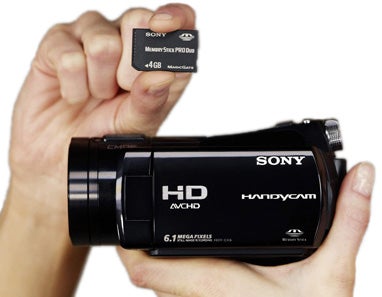
There are four AVCHD recording modes available, ranging from LP at 5Mbits/sec to XP at 15Mbits/sec, with SP and HQ modes in between. Standard definition can be recorded in MPEG-2 format from 3Mbits/sec to 9Mbits/sec. At least Sony includes a 4GB piece of MemoryStick media in the box, but that will only be enough for about half an hour of video in the top XP mode. So a larger MemoryStick module will be a must.
Sony clearly sees the HDR-CX6EK appealing to gadget-lovers and home users, as there are few concessions to the more serious videomaker. An accessory shoe is available, but it’s Sony’s proprietary AI version rather than a standard-sized one. No microphone minijack nor headphone socket are incorporated, although the Sony has three microphones built in from which it blends 5.1 surround sound, recorded in Dolby Digital format. Image stabilisation comes courtesy of Sony’s Super SteadyShot optical system, rather than the resolution-reducing digital version.
The HDR-CX6EK has no lens ring, either, but that is par for the course in consumer camcorders. Instead, you will need to take a trip to the touchscreen-based menu system. This has been simplified since the original version, so you no longer have to scroll through so many options to find the one you’re after. Instead, these are distributed between five tabs. The first tab includes manual focus and Sony’s excellent spot focus, where you simply touch the portion of the frame you want to be sharp – great for focus pulling, although it’s a little slow. Tele macro is also available here.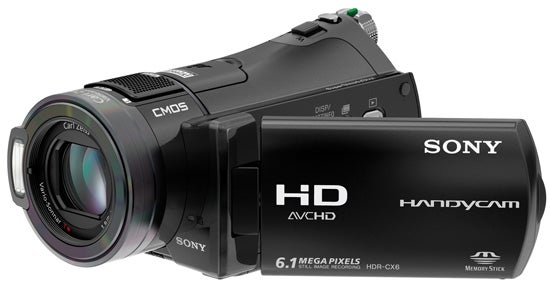
The second tab provides access to the healthy selection of Scene modes, including Twilight (and Twilight Portrait in digital camera mode), Candle, Sunrise & Sunset, Fireworks, Landscape, Portrait, Spotlight, Beach and Snow. You can also use Sony’s spot metering to set exposure, or a simple slider for fully manual control, although neither give you any idea what iris and shutter settings they correspond to. Indeed, there is no way of setting the shutter speed manually at all.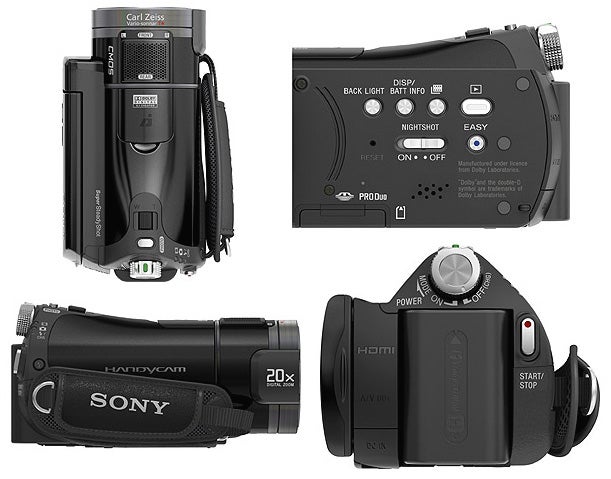
The remaining tabs offer manual, automatic and preset white balance for indoors and outdoors; colour slow shutter; various digital effects; and access to the various recording quality modes. Heading further into the full Home menu system provides access to settings like TV output, redeye reduction, and x.v.Color. The latter records a wider dynamic range, but requires a compatible HDTV for the benefits to be visible. Otherwise, it just looks like an even more exaggerated level of saturation. The Home menu is also the way you access the Smooth Slow Record function, which records video at four times the normal frame rate so that slow motion remains fluid when played back at the normal frame rate.
Overall, there is enough to satisfy the novice, without being too confusing. But both Canon and Panasonic offer considerably more manual control. Sony doesn’t really provide enough for hobbyists or video enthusiasts. There is a separate button for backlight compensation and a switch for Night Shot mode that captures monochromatic video illuminated by a built-in infrared emitter. But apart from that, every setting requires a trip to the touchscreen menu, and the key controls for aperture and shutter are absent. On the plus side, the HDR-CX6EK’s battery isn’t fully encased in the body. So you will be able to fit a larger battery than the 1,000mAh unit supplied – up to 3,980mAh in fact.
Sony tends to use the most saturation of all camcorder manufacturers, and the HDR-CX6EK is a prime example. In full sunlight, colours are extremely vibrant – particularly green. But the balance is good, and this is the kind of colour most consumers want in their video. The image doesn’t look as sharp as the HDV-based HDR-HC9E, but this is entirely due to the more aggressive AVCHD compression, which runs at nearly half the bit-rate.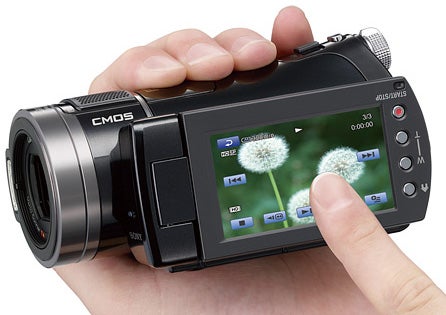
Moving to lower light – equivalent to a living room lit by a single 100W bulb – the HDR-CX6EK was even more impressive for a single-chip camcorder. Colour balance remains excellent, and vibrancy is only a little muted compared to daylight. There is a fair amount of grain, however. Canon’s HG10 and HV20 are both much cleaner in this level of illumination. The noise increases as the light drops, and although the HDR-CX6EK maintains more colour than many, the grain still ruins its chances. Few consumer camcorders operate well in this level of light, though, and the Sony is still much better than average.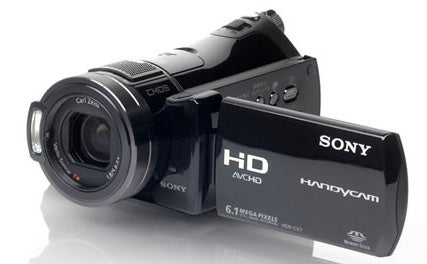
On the camcorder body itself there is only HDMI and a proprietary A/V connection, which provides composite video and stereo RCA audio output. But a docking station is supplied, which also incorporates an A/V connection and adds component video and USB 2.0 for importing your video files into an editing system. Being AVCHD, the HDR-CX6EK’s footage won’t be hard to edit these days, although it’ll be processor intensive. The AVCHD format is supported by Pinnacle Studio 11 Plus, Ulead VideoStudio 11 Plus, and Sony Vegas 8 – but not Adobe Premiere Elements 4.
”’Verdict”’
Sony hasn’t produced a camcorder with quite the pocket-friendly appeal of Panasonic’s HDC-SD9. But it is capable of great-looking video in the kinds of conditions the average consumer will be shooting. Sony has focused on achieving this with as little user intervention as possible, but sacrificed manual control on the way. So the HDR-CX6EK will appeal to those who just want to point and shoot, leaving more serious video makers to look elsewhere.
Trusted Score
Score in detail
-
Image Quality 8
-
Features 7
-
Value 7
Image Processor
| Image Sensor Quantity | 3 |
| Image Sensor Size (Millimeter) | 8.38 mm |
Lens Features
| Digital Zoom (Times) | 18x |
Video Recording
| Recording Media | Memory Card |
| Video Capture Format | HDV, DV |
| Max Video Res | 1920 x 1080 |
| Minimum Lux Rating (Lux) | 1.5 luxlx |
General Features
| LCD Screen Size (Inch) | 3.2 in |


